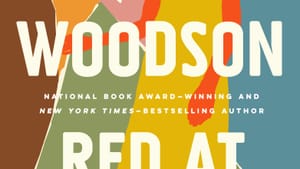Stay in the Loop
BSR publishes on a weekly schedule, with an email newsletter every Wednesday and Thursday morning. There’s no paywall, and subscribing is always free.
Destiny beyond family
‘Red at the Bone’ by Jacqueline Woodson

As the pandemic crisis continues, we need to remain calm and keep love in our hearts. If you need a release from reading the news while in quarantine, Jacqueline Woodson’s slim novel Red At The Bone touches on the fine points of family.
Pain, healing, and hope
Woodson takes a poetic approach to class, race, and death, and fashions a work without villains—though the woman is the heartbreaker in this story. The book opens on Melody’s coming-of-age ceremony. As her family gathers, we witness a rocky relationship with her mother, Iris, and her father, Aubrey. We follow the aftermath of a fiercely independent woman’s sacrifice when she’s faced with choosing her destiny or keeping up appearances with her family. Deep emotional wounds arise, hidden and revealed.
The narrative speaks of pain, but another theme sticks out, too: healing and hope. In 200 breathtaking pages, Woodson shows what it's like to be a Black girl in America. Teen pregnancy gets a unique touch not often found in other books about privileged families and struggling single mothers. This is not a familiar tale of a man wanting to run and a woman fulfilled with her domestic existence. All the book’s characters evoke empathy, even when they make bad choices—or leave permanent scars on the ones they love most.
Every word counts
The author has a knack for making every word count. Transitioning from present to past, Woodson continuously shakes up the narrative. We are rewarded with a fully developed look into Iris’s thoughts. She realizes at a young age that she is responsible for her own happiness.
Woodson tosses the symbolism of chicken bones throughout the novel, like the unappealing, undercooked flesh that Melody watches white girls gobbling. The bones also express uncomfortable emotions that are hard to face. When Iris finds love with another woman, she has a devastating revelation: “She felt red at the bone—like there was something undone and bleeding.”
The language becomes more beautiful as the story progresses, no more so than as we journey further back in time: Iris’s mother, Sabe, grew up during the Tulsa race riots. “Even though it happened twenty years before I was even a thought, I carry it. I carry the goneness,” Iris says.
Before we know who we are
The intentional atmosphere comes full circle. With rich details that steep the reader in the ache of abandonment, Iris tells Melody, years later, that she was wanted. The past is kept alive and burning—like the Black businesses and schools in Tulsa circa 1921.
“You rise in your Lord & Taylor cashmere coat and refuse to let shame stand beside you,” Woodson writes.
This story resonated with me, particularly as a single mother. Like Woodson’s protagonist, I also attended college and worked while having a toddler. I didn’t see her much. Now that I think about it, my absence may have felt like that of the mother in Woodson’s novel. It’s not easy to admit, but I was young and had no idea who I was yet. I did the best I could. This story lets me recognize my younger self—the self who was uncertain about her path in life.
There’s no better time than quarantine to think about your history, and anyone who likes mother/daughter sagas will enjoy Red at the Bone. This is the time to appreciate each other. Even in isolation, you can read this book and feel the door is always open.
What, When, Where
Red at the Bone. By Jacqueline Woodson. New York: Riverhead Books, September 17, 2019. 208 pages, hardcover; $26.00. Get it here.
Sign up for our newsletter
All of the week's new articles, all in one place. Sign up for the free weekly BSR newsletters, and don't miss a conversation.

 Andrea Smith
Andrea Smith